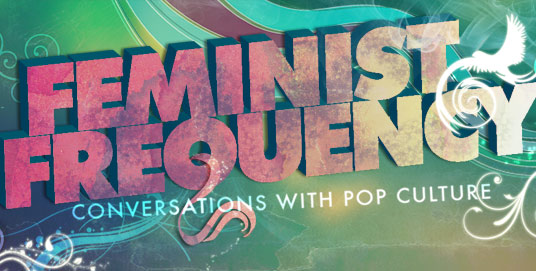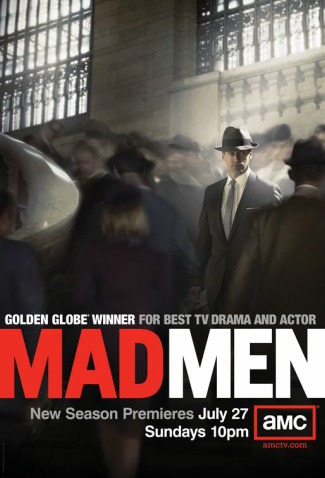Anita Sarkeesian of the Web site
Feminist Frequency, a site that analyzes pop culture from a feminist perspective, recently completed her fabulous, six-part video series on
Tropes vs. Women. She explains that, “A trope is a common pattern in a story or a recognizable attribute in a character that conveys information to the audience. A trope becomes a cliche when it’s overused. Sadly, some of these tropes often perpetuate offensive stereotypes.”
I highly recommend watching each of these six videos. Sarkeesian possesses a strong ability to analyze often complicated issues regarding gender roles and the representations of women in film and television, and she breaks things down into more easily understandable ideas. The run time of each video is between five and ten minutes, with many television and movie clips incorporated as examples for the particular trope she’s highlighting. They helped me! Go watch them!
 Definition
Definition: “The Manic Pixie Dream Girl is a cute, bubbly, young (usually white) woman who has recently entered the life of our brooding hero to teach him how to loosen up and enjoy life. While that might sound all well and good for the man, this trope leaves women as simply there to support the star on his journey of self discovery with no real life of her own.”
Example: “You might remember Zooey Deschanel in 500 Days of Summer, the non-committing love interest of the film’s star, Tom Hansen, played by Joseph Gordon-Levitt. The story follows Tom on his journey of falling in and out of love with Summer Finn. They have the classic Manic Pixie Dream Girl scene where they are frolicking around in the world, and the Manic Pixie teaches the uptight star how to embrace his inner child.” [accompanied by film clip]
 Definition
Definition: “Women in Refrigerators is a trope identified by comic book fan (and now comic book writer) Gail Simone because she was sick of seeing “superheroines who have been either depowered, raped, or cut up and stuck in the refrigerator.”
Example: “While the Women in Refrigerators trope originated in the comic book genre, it can be applied across other pop culture mediums, such as video games, TV shows, and movies. For example, Libby and Shannon on Lost were murdered specifically to push the story arc of two male characters. Or how about all of these women from Heroes who were depicted as losing or being unable to control their powers.”
 Definition
Definition: “The Smurfette Principle was named two decades ago by Katha Pollitt, when she noticed that there were a disproportionate amount of male characters in programming aimed at young people. Even in adult programming, when women do appear in the primary cast of a television show or movie, they are usually alone in a group of men. Sadly, this trope has made its way into the 21st century.”
Example: “Down in the 100-acre woods, we follow the adventures of Winnie the Pooh, Rabbit, Piglet, Eeyore, Owl, and Tiger–all dudes of course; in fact, there’s only one female character, Kanga, who shows up occasionally as the mother of little Roo. Even Jim Hensen didn’t seem too keen on the women; alongside Kermit, Gonzo, and Fozzie the Bear, Miss Piggy was the only female muppet. We can even see The Smurfette Principal outside of programming aimed at young people. So, for example, you have George Lucas’ original Star Wars trilogy, where Princess Leia is the only principle female character in the entire galactic empire.”
 Definition
Definition: “The Evil Demon Seductress is a supernatural creature–usually a demon, alien, robot, vampire, etc.–who is most often disguised as a sexy human female. She uses her sexuality and sexual wiles to manipulate, seduce, kill, and often eat, poor, hapless men by luring them into her evil web.”
Example: “In Star Trek: First Contact, we have the Borg Queen trying to seduce Data. Keanu Reeves is taken advantage of by the Brides of Dracula. And then some years later, in Buffy the Vampire Slayer, Giles meets these three sisters. In the science fiction show, Farscape, there’s the villain, Grayza, with her enchanting body sweat. There are the evil mermaids in Pirates of the Caribbean 4. And Mystique in X-Men often fulfills this trope.”
 Definition
Definition: “The Mystical Pregnancy is a trope writers use to create drama and terror by invading, violating, and exploiting women’s reproductive capabilities. Often these female characters have their ovaries harvested by aliens or serve as human incubators for demon spawn. Sometimes, they are carrying the Messiah, and other times Satan himself.”
Example: “Remember back in the mid-90s on the X-Files when FBI Agent Dana Scully found herself abducted and forcibly impregnated, which, of course, later culminated in a hybrid human-alien child? More recently, on the second season of Battlestar Galactica, Starbuck had her ovaries harvested by the cyclons in an attempt to create human-cyclon embryos. Then we have Gwen Cooper, co-star of the Doctor Who spinoff, Torchwood, who is bitten by an alien one night, and the next morning she wakes up to find herself extremely pregnant with the alien’s spawn.”
 Definition
Definition: “In television and movies, The Straw Feminist works by deliberately creating an exaggerated caricature of a feminist, which writers then fill with a bunch of oversimplifications, misrepresentations, and stereotypes to try to make it easy to discredit or delegitimize feminism. The goal is to make feminists and our movements look completely ridiculous, over the top, and unnecessary.”
Example: “The Straw Feminist trope is taken to a whole new level in adult animation shows such as South Park or Family Guy. In the episode, “I Am Peter, Hear Me Roar,” the Family Guy writers took a stab at feminist attorney Gloria Allred. Allred is known for taking on high-profile cases defending women who have been assaulted or harassed. In this attack, the Family Guy writers created a character coincidentally named Gloria Ironbox, who brainwashes Peter into thinking he is a woman after he’s accused of sexual assault. The emasculation and feminization of Peter–and his sudden transformation into a feminist–is played for laughs.”
This six-part video series also appeared at
Bitch Magazine, and the comment threads–both at
Bitch and at
Feminist Frequency–always offer excellent discussions of the videos.









